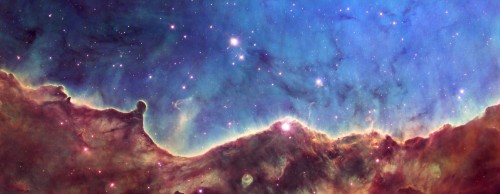Explanation: Bright young stars sometimes sculpt picturesque dust mountains soon after being born. Created quite by accident, the energetic light and winds from these massive newborn stars burn away accumulations of dark dust and cool gas in a slow but persistent manner. Such is the case in NGC 3324, a star forming region near the edge of NGC 3372, the energetic and expansive Carina Nebula. Pictured above, in scientifically assigned colors, is only a small part of NGC 3324. The Carina Nebula itself is one of the largest star forming regions known and home to Eta Carinae, one of the most unstable and variable stars known. The above image was created from archived Hubble Space Telescope data in honor of the 10th anniversary of the Hubble Heritage Project. The Hubble Heritage Project has created, so far, nearly 130 visually stunning images.
antwrp.gsfc.nasa.gov/apod/image/0810/ngc3324_hst_big.jpg





Sweet.
And Nebula is such a beautiful word.
Actually Wiki has an even better picture – this is huge, but amazing (and, in slightly shrunk-and-cropped form, just became my wallpaper).
upload.wikimedia.org/wikipedia/commons/2/2a/Eta_Carinae_Nebula_1.jpg
Did you know those colors are actually representing the elements of it, all Hubble brings back is Black and White and they spend years coloring it properly .
i think Blue is Oxygen, red is sulfur, green is hydrogen, and the rest i don’t remember.
pretty crazy eh, Celestial art, no human could create such beauty as such created by the force of all the energy in the universe.
@...Cargen: uh, no. it has multiple filters, and has the ability to take just black and white images, but it’s definitely able to take color images as well. Check out the HubbleSite for more information on this, but to put it succinctly, it takes three pictures of each of the three primary colors and combines them to make one color image.